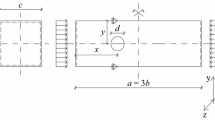Abstract
The circular tube squaring process is examined by a three-dimensional elastic-plastic finite element method, which is based on Prandtl-Reuss flow rule and Hill’s yield criterion, associating with an updated Lagrangian formulation. The high nonlinearity of the process due to the geometric changes, the inelastic constitutive behavior, and the boundary conditions being varied with deformation is taken into account in an incremental manner. In terms of the contact boundary, a modified Coulomb friction mode is specially considered. A weighting factor rmin is employed to limit the step size of loading increment to linear relation. The simulated geometry of squaring clearly demonstrates the tube squaring process till unloading. The squaring defects of formation, both collapse and asymmetry, are reported herein. Accordingly, the effects of various parameters, such as geometric ratio R/t, strain hardening exponent n, friction coefficient μ, and the length of tube L, on the occurrence of collapse (collapse ratio C/t, Cm/t, δ1/t, δ2/t, a measurement of the extent of collapse) and the extent of asymmetry (deviation ratio C1/C2) in the tube squaring process are discussed and interpreted in the simulation. The simulation clearly demonstrates the efficiency of the model simulating the tube squaring process. Mainly, it is expected that the formation of a square tube for industrial use without collapse will be found during the design stage, before beginning trials. The present work may be expected to improve the understanding of the formation of square tubes.
Similar content being viewed by others
References
Huang, Y. M., “Finite element analysis of tube inward curling process by conical dies,” J. Mater. Process. Technol., Vol. 170, No. 3, pp. 616–623, 2005.
Johnson, W., Reid, S. R., and Reddy, T. Y., “The compression of crossed layers of thin tubes,” Int. J. Mech. Sci., Vol. 19, No. 7, pp. 423–437, 1977.
Wang, J. J., Lee, J., Woo, C. S., Kim, B. K., and Lee, S. B., “An experimental study and finite element analysis of weatherstrip,” Int. J. Precis. Eng. Manuf., Vol. 12, No. 1, pp. 97–104, 2011.
Mutchler, L. D., “Energy Absorption of Aluminum Tubing,” Journal of Applied Mechanics, Vol. 27, No. 4, pp. 740–743, 1960.
Hwang, W. C., Lee, K. S., Yang, Y. J., and Yang, I. Y., “An experimental study on the optimum collapse characteristics of composite structural member under impact loading,” Int. J. Precis. Eng. Manuf., Vol. 12, No. 3, pp. 521–526, 2011.
Leu, D. K., “The shaping of a circular tube into a symmetric square-tube by finite-element modeling,” J. Mater. Process. Technol., Vol. 178, No. 1–3, pp. 287–296, 2006.
Yamada, Y., Yoshimura, N., and Sakurai, T., “Plastic stressstrain matrix and its application for the solution of elasticplastic problems by the finite-element method,” Int. J. Mech. Sci., Vol. 10, No. 5, pp. 343–354, 1968.
McMeeking, R. M. and Rice, J. R., “Finite-element formulations for problems of large elastic-plastic deformation,” Int. J. Solids Struct., Vol. 11, No. 5, pp. 601–616, 1975.
Cao, H. L. and Teodosiu, C., “Finite element calculation of springback effects and residual stress after 2D deep drawing,” Proceedings of the Computational Plasticity — fundamentals and applications, pp. 959–971, 1989.
Ahmad, S., Irons, B. M., and Zienkiewicz, O. C., “Analysis of thick and thin shell structures by curved finite elements,” Int. J. Numer. Methods Eng., Vol. 2, No. 3, pp. 419–451, 1970.
Dvorkin, E. M. and Bathe, K. J., “A continuum mechanics based four-node shell element for general non-linear analysis,” Eng. Comput., Vol. 1, No. 1, pp. 77–88, 1984.
Nakamachi, E., “Computer aided simulation of sheet metal forming procedures by thin shell finite element analysis,” Advanced Technology of Plasticity, Vol. 4, pp. 1745–1750, 1990.
Santos, A. and Makinouchi, A., “Contact strategies to deal with different tool descriptions in static explicit FEM for 3-D sheet metal forming simulation,” Proceedings of Numisheet’93, pp. 261–273, 1993.
Michalowski, R. and Mroz, Z., “Associated and non-associated sliding rules in contact friction problems,” Arch. Mech., Vol. 30, No. 3, pp. 259–276, 1978.
Huang, Y. M. and Leu, D. K., “Finite element analysis of contact problems for a sheet metal bending process,” Comput. Struct., Vol. 57, No. 1, pp. 15–27, 1995.
Kitazawa, K., “Criteria for outward curling of tubes,” Trans. ASME, J. Eng. Ind., Vol. 115, No. 4, pp. 466–471, 1993.
Deruntz, J. J. A. and Hodge, J. P. G., “Crushing of a Tube Between Rigid Plates,” Trans. ASME, J. Appl. Mech., Vol. 30, No. 3, pp. 391–395, 1963.
Author information
Authors and Affiliations
Corresponding author
Rights and permissions
About this article
Cite this article
Chen, TC., Ye, JM. Collapse analysis of the squaring circular tube using finite element method. Int. J. Precis. Eng. Manuf. 13, 1563–1574 (2012). https://doi.org/10.1007/s12541-012-0206-0
Received:
Accepted:
Published:
Issue Date:
DOI: https://doi.org/10.1007/s12541-012-0206-0




